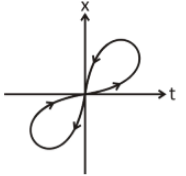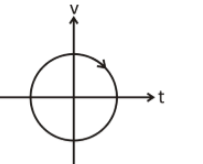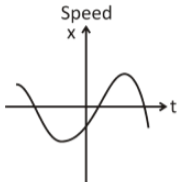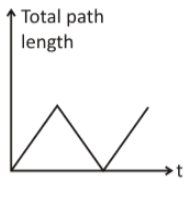
Look at the graphs (a) to (d) carefully and state, with reasons, which of these cannot possibly represent one-dimensional motion of a particle.
A.

B.

C.

D.





Answer
554.1k+ views
Hint:Here we have to apply the concepts of velocity time graph and also apply the concepts of motion. Objects moving in straight lines are described by one dimensional motion. If the velocity of an object changes with time, it is said that the object is accelerating. When limited to one dimension, the velocity and acceleration vectors can point in only two possible directions.
Complete answer:
An object's velocity is its speed in a given direction. The speed and distance an object moves over a given span of time is displayed by a velocity-time graph. Velocity-time graphs are sometimes called graphs of speed-time. The vertical axis in a time-velocity graph is the object's velocity.
In mechanics, acceleration is the rate at which an object's velocity varies in response to time. Accelerations are (in that they include magnitude and direction) vector quantities. The direction of the acceleration of an object is provided by the orientation of the net force which acts on that object.
In figure A we can see that there are two different paths for the time and displacement graph. But it is not possible for a particle to exist simultaneously in two different places. So, graph A cannot represent one dimension.
Graph B does not reflect one-dimensional motion since, if the motion is one-dimensional, a particle does not have a positive and negative velocity at the same moment.
Positive velocity means we are travelling in one direction while we are travelling down a path, and negative velocity implies we are heading in the other direction. Speed is the velocity vector's magnitude, and is therefore often positive. So, graph C also does not represent motion in one dimension.
A positive scalar quantity that does not decrease over time and can never be zero for a moving body is path length or width. A body's displacement may be zero. The displacement magnitude will never be greater than the distance. Hence, graph D also does not represent one-dimensional motion.
Note:A direction does not matter in one dimension since; the motion travels in one direction only. So, the arrows given in the graphs do not matter.Linear motion is the simplest kind of one-dimensional motion. As Newton’s first law of motion suggests, an object will either be at rest or continue to move in a straight line with a uniform velocity unless and until an external force is applied to it.
Complete answer:
An object's velocity is its speed in a given direction. The speed and distance an object moves over a given span of time is displayed by a velocity-time graph. Velocity-time graphs are sometimes called graphs of speed-time. The vertical axis in a time-velocity graph is the object's velocity.
In mechanics, acceleration is the rate at which an object's velocity varies in response to time. Accelerations are (in that they include magnitude and direction) vector quantities. The direction of the acceleration of an object is provided by the orientation of the net force which acts on that object.
In figure A we can see that there are two different paths for the time and displacement graph. But it is not possible for a particle to exist simultaneously in two different places. So, graph A cannot represent one dimension.
Graph B does not reflect one-dimensional motion since, if the motion is one-dimensional, a particle does not have a positive and negative velocity at the same moment.
Positive velocity means we are travelling in one direction while we are travelling down a path, and negative velocity implies we are heading in the other direction. Speed is the velocity vector's magnitude, and is therefore often positive. So, graph C also does not represent motion in one dimension.
A positive scalar quantity that does not decrease over time and can never be zero for a moving body is path length or width. A body's displacement may be zero. The displacement magnitude will never be greater than the distance. Hence, graph D also does not represent one-dimensional motion.
Note:A direction does not matter in one dimension since; the motion travels in one direction only. So, the arrows given in the graphs do not matter.Linear motion is the simplest kind of one-dimensional motion. As Newton’s first law of motion suggests, an object will either be at rest or continue to move in a straight line with a uniform velocity unless and until an external force is applied to it.
Watch videos on
Look at the graphs (a) to (d) carefully and state, with reasons, which of these cannot possibly represent one-dimensional motion of a particle.
A.

B.

C.

D.

A.

B.

C.

D.


Motion in a Straight Line Class 11 Physics - NCERT EXERCISE 2.12 | Physics NCERT | Chandan Sir
Subscribe
 Share
Share likes
27K Views
2 years ago
Recently Updated Pages
Master Class 11 Economics: Engaging Questions & Answers for Success

Master Class 11 English: Engaging Questions & Answers for Success

Master Class 11 Social Science: Engaging Questions & Answers for Success

Master Class 11 Biology: Engaging Questions & Answers for Success

Class 11 Question and Answer - Your Ultimate Solutions Guide

Master Class 11 Business Studies: Engaging Questions & Answers for Success

Trending doubts
What is meant by exothermic and endothermic reactions class 11 chemistry CBSE

1 Quintal is equal to a 110 kg b 10 kg c 100kg d 1000 class 11 physics CBSE

What is periodicity class 11 chemistry CBSE

Explain zero factorial class 11 maths CBSE

What is a periderm How does periderm formation take class 11 biology CBSE

What are porins class 11 biology CBSE



 Watch Video
Watch Video
